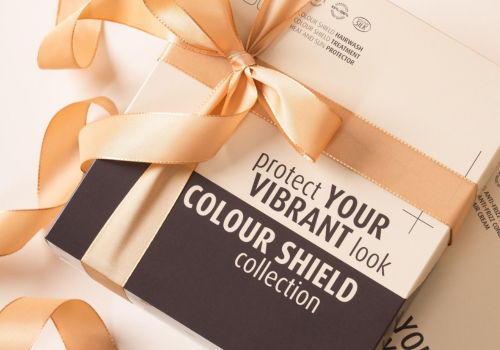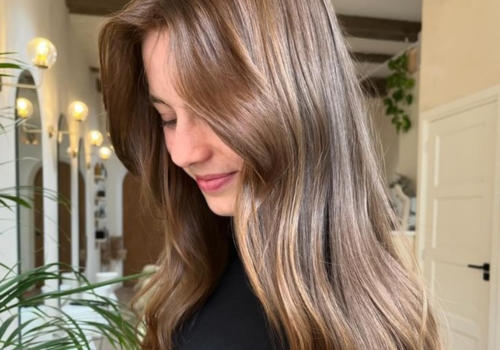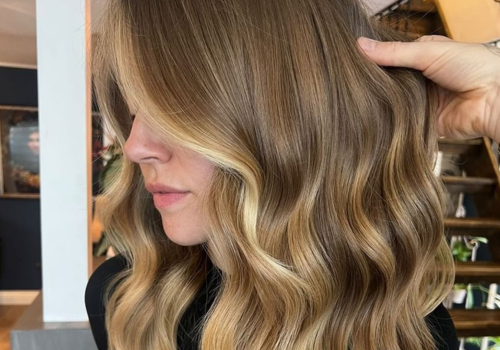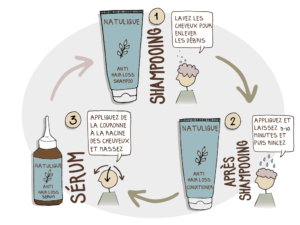Preparing to apply Haircolour
Choose the right colorant
Understanding the difference between permanent and semi-permanent hair color
- Visit permanent coloring penetrates the hair shaft and permanently changes hair color. It's ideal for those looking for a radical, permanent change.
- Visit semi-permanent coloring does not penetrate as deeply and fades after several washes. It's perfect for those who want to experiment without a long-term commitment.
Choosing the right color for your skin tone and natural hair color
- Fair complexion : Colors like blond, light brown and red work well.
- Medium complexion : Shades of medium brown, chestnut and burgundy are ideal.
- Dark complexion : Rich colors like dark browns, blacks and deep reds work well together.
- For naturally dark hairIt may be necessary to bleach before applying a lighter shade.
- For naturally light hairFor a more elegant look, opt for a color two or three shades darker or lighter than your natural skin tone.
Preparing the hair and scalp
Cleansing hair: Pre-color shampoo
- It is advisable to wash your hair one day before applying the color with a clarifying shampoo to remove styling product residues.
- Avoid overly nourishing conditioners or care products before applying color, as they can create a barrier that prevents color from penetrating properly.
Moisturize the scalp: Apply conditioner
- Apply a moisturizing conditioner to hair ends a few days before coloring to prevent them from drying out during the process.
- If you have a sensitive scalp, use a protective cream on the edges of the hairline to protect the skin from irritation.
Preparation of staining material
Make sure you have all the tools you need
- A non-metallic bowl for mixing the color.
- An application brush for even distribution of the stain.
- Plastic gloves to protect your hands.
- Clips or elastics to divide your hair into sections.
- A fine-tooth comb for precise separation of hair sections.
- An old towel or coloring cape to protect your clothes.
Preparing the coloring mixture
- Read the instructions on the packaging carefully. Each brand and type of hair color may have specific instructions.
- Follow the recommended proportions for mixing color and oxidizer.
- Be sure to mix thoroughly to a homogeneous consistency for even application.
- Leave the mixture to stand for the time indicated to allow the ingredients to activate properly.

Color application
How to apply color
Dividing hair into sections
- Before starting application, it's essential to divide your hair into sections for easier, more even application.
- Use a fine-tooth comb and clips to divide your hair into four main sections: two at the front and two at the back.
- Secure each section with pliers to keep it in place while you work.
- Start by working on the sections at the back of your head, then move on to the front sections.
Section-by-section color application
- Put on your plastic gloves to protect your hands from colored stains.
- Using your application brush, start applying the dye from the roots to the ends.
- Work strand by strand, taking small sections of hair to ensure complete coverage.
- Apply the dye evenly, making sure to saturate each strand of hair. Avoid overloading with product, which can lead to staining or poor color penetration.
- Comb through each strand after application to distribute the product evenly and avoid build-up.
- Repeat the process for all sections until all your hair is coated with dye.
Tips for even application
Precise application to avoid stains
- Protect your skin by applying a moisturizer or petroleum jelly around the hairline, ears and nape of the neck to avoid unwanted spots on your skin.
- Be careful when applying dye close to the hairline to avoid spillage. Use a finer brush for hard-to-reach areas like the temples and nape of the neck.
- Use an old towel or a suitable cape to protect your clothes from splashes of color.
Using the cross technique for complete coverage
- The cross technique involves dividing hair into four equal sections by tracing a cross on the scalp with a comb. This helps to manage long or thick hair more easily.
- Start by applying the stain to the rear sections using a horizontal sweeping motion, then move on to the front sections using a vertical motion.
- Alternate horizontal and vertical movements to ensure that each strand of hair receives an even amount of dye.
- If you're dying your hair for the first time, start with the ends and work your way up to the roots to avoid excessive color saturation at the scalp.
- For touch-ups, first apply the dye to the regrown roots, then extend the hair towards the ends only if necessary to refresh the color.
See also: How can I get gray hair without bleaching?
Post-Color Treatment
Rinsing and cleaning
Dye rinsing
- Once the application time has elapsed, start by rinsing your hair with lukewarm water. Avoid water that's too hot, as it can damage dyed hair.
- Rinse your hair until the water runs clear. This may take a few minutes, especially if you've used a dark color.
- Use your fingers to gently massage your scalp to remove all dye residues.
Use a post-coloration shampoo
- After rinsing the tincture thoroughly, apply a specially formulated shampoo for color-treated hair. These products help preserve color and prolong wear.
- Avoid shampoos containing sulfates, as they can cause color to fade more quickly.
Applying after-colour care
- Use a conditioner or moisturizing hair mask to deeply nourish your newly-dyed hair.
- Apply conditioner mainly to the lengths and ends of your hair. Leave on for a few minutes before rinsing with warm water.
- If you have the time, a hair mask can provide extra hydration. Leave it on for 5-10 minutes before rinsing.
- For optimum care, use a repair mask once a week to maintain the health and shine of your color-treated hair.
Drying and styling dyed hair
Dry dyed hair properly
- After rinsing, gently blot your hair with a clean towel. Do not rub your hair, as this can damage it and cause breakage.
- Use a wide-tooth comb to gently detangle your hair. Avoid using a brush, as wet hair is more vulnerable to breakage.
- Air-dry your hair as much as possible to avoid heat damage. If you must use a hair dryer, opt for a low or medium heat setting.
Styling hair after coloring
- To preserve the color and health of your hair, apply a thermal protection spray before using heated tools such as a straightening iron or curler.
- To add shine and softness, use a few drops of hair serum or light oil on damp hair or after blow-drying.
Maintain color between applications
Use specific hair care products
- Invest in hair products designed for color-treated hair, such as sulfate-free, moisture-rich shampoos and conditioners.
- Use a dry shampoo between washes to avoid washing your hair too often and preserve color.
Avoid fading factors
- Minimize exposure to the sun, chlorinated pools and salt water, as these elements can accelerate fading.
- Wear a hat or use UV protection spray when outdoors to protect your hair from the sun's rays.
Regular touch-ups
- To maintain vibrant color, plan to touch up every 4 to 6 weeks, depending on hair growth and color fading.
- For repoussé roots

FAQ and Conclusion
Frequently asked questions
When is the best time to color your hair?
The best time to color your hair is when it's lightly soiled. The natural oils produced by your scalp will help protect the skin during the coloring process.
How long should I wait before washing my hair after coloring?
We recommend waiting at least 48 hours after coloring before washing your hair. This allows the color to set properly in the hair shaft.
Do I need to use any special care after coloring?
Yes, it's crucial to use hair products specifically designed for color-treated hair. This includes sulfate-free shampoos, moisturizing conditioners and nourishing hair masks.
How can I prevent my color from fading too quickly?
To prevent your color from fading, use anti-UV products, reduce the frequency of washing and avoid excessive exposure to the sun and chlorinated pools.
Can I color my hair if I already have another color?
Yes, but it's essential to choose a color that works well with your current shade. You may also need to bleach your hair before applying a new color to achieve the desired result.
Conclusion
By following each of the steps described, you can achieve impeccable hair color at home. From choosing the right shade to meticulous application and after-care, every detail counts to achieve perfect hair color. Don't forget to use products specially formulated for colored hair to maintain the shine and vitality of your new hue. Enjoy your new look with confidence, and be sure to nourish your hair regularly to keep it healthy.





